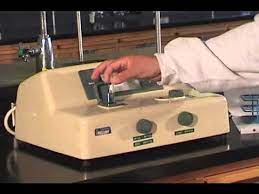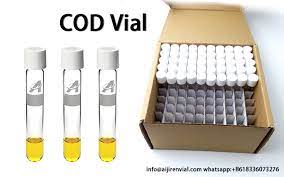Chemical Oxygen Demand (COD)
Chemical Oxygen Demand (COD) is an important measurement for the treatment of waste in many industrial sectors, from municipal systems to the waste stream feed mills.
Correct COD testing is important in determining the effectiveness of your water treatment, and can help diagnose any treatment problems that may arise. In this blog we will explain what chemical oxygen demand is, how to analyze it and how to know which is the best equipment to carry out your analyzes.
- What is COD?
- Importance of COD
- How is COD measured?
- “So what do I need to start the analysis?”
What is Chemical Oxygen Demand?
Chemical oxygen demand (COD) is an indirect measurement of the amount of organic matter in a sample. With this test, you can measure virtually all organic compounds that require a reagent to go through the digestion process.
COD differs from Biochemical Oxygen Demand (BOD), which is based on the use of microorganisms that break down organic material in the sample through aerobic respiration during a specified incubation period (usually 5 days).
COD and BOD have a correlation in practically all samples, but BOD is always lower than COD, since the biochemical decomposition of organisms is often not as complete as with the chemical method.
Importance of Chemical Oxygen Demand
When evaluating organic matter in a wastewater sample, both BOD and COD are of great importance in determining the amount present. Waste with a high organic content requires a treatment that reduces its quantity before being discharged into receiving waters.
If the water treatment facilities do not reduce the organic content of the wastewater before entering the natural waters, the microbes in the receiving water will consume this organic matter.
Consequently, these microbes will also consume the oxygen in the receiving water as part of the decomposition of organic waste. The depletion of oxygen, along with nutrient-rich conditions, is called eutrophication, which is a natural water condition that can lead to the death of animal life.
Wastewater facilities reduce COD and BOD using these same microbes under controlled conditions. These facilities aerate chambers injected with a special bacteria that can decompose organic matter in an environment that does not harm natural waters. In these facilities, the reduction in BOD is used as a benchmark to determine the effectiveness of the treatment.
Because the BOD analysis takes 5 days to complete, COD is used to monitor the treatment process in daily operations. The COD analysis only takes a few hours to complete.
If BOD was always used, the wastewater treatment would have to stop and any problems in the treatment process would not be discovered until 5 days later. This means that the wastewater would have to be held until the results are verified.
Hanna’s Tip: Due to the speed of the analyzes, facilities usually establish a correlation between BOD and COD, so they only run the BOD analysis occasionally; however, be sure to get detailed advice from your local regulatory agency on BOD and COD testing regimes.
How to Measure Chemical Oxygen Demand
As mentioned above, COD measures organic matter using a chemical oxidant. It is critical that an oxidant strong enough to react with virtually all organic material in the sample is used. Traditionally, potassium permanganate has served this role, but its ability to oxidize all organic matter in a wide variety of waste samples was found to be inconsistent.
Currently, most COD tests use potassium dichromate as the oxidant. This is a bright orange hexavalent chromium salt and a very strong oxidant. Between 95% to 100% of the organic material can be oxidized with dichromate. Once it oxidizes a substance, it is converted to a trivalent form of chromium, which is a dull green color.
The digestion process is carried out on the samples with a certain amount of the oxidant, sulfuric acid and heat (150 ° C). Generally, metal salts are incorporated to suppress any interference and catalyze the digestion process, which usually takes 2 hours.
During the digestion process it is necessary to have an excess of oxidant; this ensures complete oxidation of the sample. Therefore, it is important to determine the amount of excess oxidant. The two most common methods for this are titration and colorimetry.
COD Titration
In the titration method for determining COD, the surplus dichromate reacts with a reducing agent, ferrous ammonium sulfate (FAS); By adding the sulfate slowly, the excess dichromate is converted to its trivalent form.
When all the excess dichromate reacts, an equivalence point is reached. This point indicates that the amount of ferrous ammonium sulfate you added equals the amount of excess dichromate. Colored indicators can also signal this end point, but the process can be automated with a potentiometer indicator, such as an electrode.
You can then calculate how much dichromate went into oxidation of the organic material based on how much was added at the beginning and how much was left.

COD Colorimetric Method You can also tell the consumption of dichromate by observing the change in absorbance of the sample. Samples are absorbed at certain wavelengths due to the color of trivalent chromium (Cr3+) and hexavalent chromium (Cr6+).
This is why you can quantify the amount of trivalent chromium in a sample after the digestion process, by measuring the absorbance of the sample at a wavelength of 600 nm in a photometer or spectrophotometer. As an alternative to determining COD values, the absorbance of hexavalent chromium at 420 nm can be used to establish the amount of excess chromium at the end of the digestion process.

This is an easy method that requires only a few steps.
- Perform the digestion process on samples and on a reagent blank. The reagent blank is just a sample of deionized water that is handled in the same way as your actual samples. You can even reuse the reagent blank for the life of your reagent lot.
- Allow the digestion process and blank samples to cool.
- Zero the instrument using a blank vial.
- Read the sample results.
What is the Best Method
The titration is less intensive for the equipment, since all you need is a buret, a thermoreactor and digestion vials; however, the procedure is a bit more time consuming. An automatic titration can reduce the amount of user input data and can be used for other wastewater applications such as alkalinity and volatile acidity.
Although colorimetry requires a spectrophotometer or photometer, it is convenient as most manufacturers offer premixed reagents, so all you have to do is run your samples with the digestion chemicals and have minimal contact.
Colorimetry also makes measurement easy as all the analyst has to do is go through the sample digestion process and let the team do the work. For this reason, colorimetry is the most common method for measuring COD.
“So what do I need to start the Measurements?”
Only a few pieces of equipment are required to get started with chemical oxygen demand. Because it is the most common method, we will focus on the colorimetric method for COD.
Here are the basics you need:
1. Thermal Block
Both methods for COD analysis require the step of the digestion process, so a heat block is essential to ensure that your samples give accurate and repeatable results. To improve these results, look for a thermal block that covers different temperatures, with this you will have the opportunity to use it for other analyzes, such as total phosphorus. Most thermoblocks have timers, which are critical for keeping digestion times consistent across different runs.
For added safety look for models that have an optional protective safety cover that covers the thermoblock in the event of an accident.
2. Spectrofotometer or Colorimeter
The Spectrofotometer or Colorimeter is the device that will read the absorbance of the samples after the digestion process to correlate it with the COD. Both pieces of equipment can be used to perform COD measurements, but the two devices are slightly different from each other.
Colorimeters use filters for measurements of light with specific wavelengths, while spectrophotometers use a device that allows measurements across a broad spectrum. Regardless of which equipment you choose, look for models with pre-programmed COD methods for ease of use
3. Reagent
Reagents are one of the most important components of the COD test system. These chemicals are responsible for oxidizing organic material. It is possible to prepare internal reagents, but it is easier to buy them, which reduces contact with hexavalent chromium and strong acids. These COD vials come pre-mixed and ready to use.

